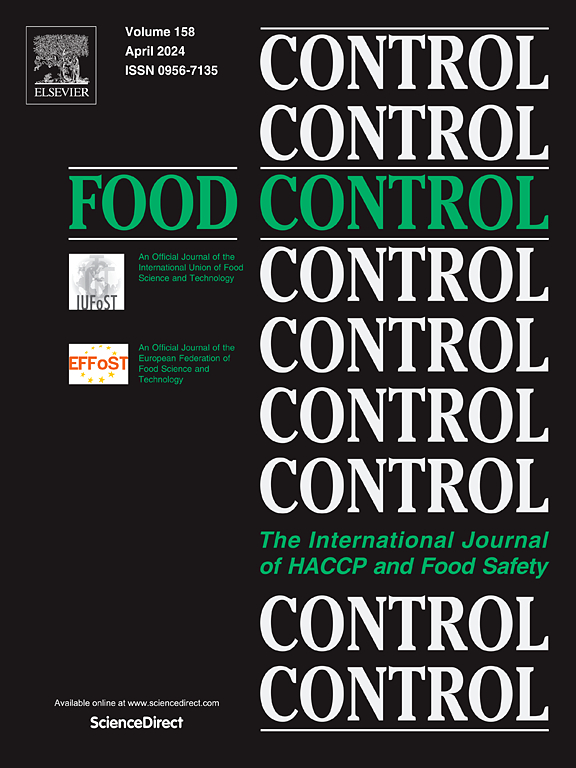Prevalence and serotype distribution of Shiga toxin-producing Escherichia coli (STEC) in raw animal and plant food samples from Kocaeli province, Türkiye
IF 5.6
1区 农林科学
Q1 FOOD SCIENCE & TECHNOLOGY
引用次数: 0
Abstract
Shiga toxin-producing Escherichia coli (STEC) is a major foodborne pathogen with significant public health risks. This study comprehensively investigated the prevalence and distribution of seven clinically important STEC serotypes and the O104 serotype, which was assessed in food samples for the first time in Türkiye. A total of 220 raw food samples beef (n = 49), chicken (n = 40), fish (n = 42), leafy greens (n = 44), and raw milk (n = 45) were collected from four regions in Kocaeli, Türkiye, between May and October 2024. Samples were analyzed for stx, eae, and serotype genes using Real-Time PCR (qPCR). Serotyping was performed with multiplex qPCR for O26, O45, O103, O111, O121, O145, and monoplex qPCR for O104 and O157. STEC was detected in 27 samples (12.27 %). Among the 46 isolates, O103 (32.60 %) was the most prevalent, followed by O157 (19.56 %), O45 (17.39 %), O121 (8.69 %), O104 (6.52 %), and others (15.21 %). This study represents the first report of STEC O104 in food samples in Türkiye, emphasizing its public health significance and the necessity for enhanced food safety surveillance. STEC prevalence was highest in beef (32.65 %), followed by raw milk (13.33 %), chicken (7.50 %), fish (2.38 %), and leafy greens (2.27 %). The most frequently detected serotypes in beef were O103 and O157, while O45 was dominant in chicken. O157 was the only serotype found in fish, whereas O103 was identified in leafy greens. Multiple serotypes, including O103, O111, and O157, were detected in raw milk. These findings underscore the need for sustained monitoring and control strategies to mitigate STEC-related risks.
产志贺毒素大肠杆菌(STEC)在泰国Kocaeli省生动植物食品样本中的流行率和血清型分布
产志贺毒素大肠杆菌(STEC)是一种具有重大公共卫生风险的主要食源性病原体。本研究全面调查了7种临床上重要的产志贺毒素大肠杆菌血清型和O104血清型的流行和分布,并首次在泰国的食品样品中进行了评估。在2024年5月至10月期间,从 rkiye省Kocaeli的四个地区共收集了220份生食品样本:牛肉(n = 49)、鸡肉(n = 40)、鱼(n = 42)、绿叶蔬菜(n = 44)和生牛奶(n = 45)。采用实时荧光定量PCR (Real-Time PCR, qPCR)检测stx、eae和血清型基因。对O26、O45、O103、O111、O121、O145进行多重qPCR分型,对O104、O157进行单效qPCR分型。27份样本(12.27%)检出产志贺毒素大肠杆菌。46株分离株中以O103(32.60%)感染率最高,其次为O157(19.56%)、O45(17.39%)、O121(8.69%)、O104(6.52%)和其他(15.21%)。本研究首次报道了日本食品样品中检测出产志贺毒素大肠杆菌O104,强调了其公共卫生意义和加强食品安全监测的必要性。产肠毒素大肠杆菌患病率最高的是牛肉(32.65%),其次是生牛奶(13.33%)、鸡肉(7.50%)、鱼(2.38%)和绿叶蔬菜(2.27%)。在牛肉中最常见的血清型是O103和O157,而在鸡肉中以O45为主。O157是唯一在鱼类中发现的血清型,而O103在绿叶蔬菜中被鉴定出来。在原料奶中检测到多种血清型,包括O103、O111和O157。这些发现强调需要持续的监测和控制策略来减轻与stc相关的风险。
本文章由计算机程序翻译,如有差异,请以英文原文为准。
求助全文
约1分钟内获得全文
求助全文
来源期刊

Food Control
工程技术-食品科技
CiteScore
12.20
自引率
6.70%
发文量
758
审稿时长
33 days
期刊介绍:
Food Control is an international journal that provides essential information for those involved in food safety and process control.
Food Control covers the below areas that relate to food process control or to food safety of human foods:
• Microbial food safety and antimicrobial systems
• Mycotoxins
• Hazard analysis, HACCP and food safety objectives
• Risk assessment, including microbial and chemical hazards
• Quality assurance
• Good manufacturing practices
• Food process systems design and control
• Food Packaging technology and materials in contact with foods
• Rapid methods of analysis and detection, including sensor technology
• Codes of practice, legislation and international harmonization
• Consumer issues
• Education, training and research needs.
The scope of Food Control is comprehensive and includes original research papers, authoritative reviews, short communications, comment articles that report on new developments in food control, and position papers.
 求助内容:
求助内容: 应助结果提醒方式:
应助结果提醒方式:


